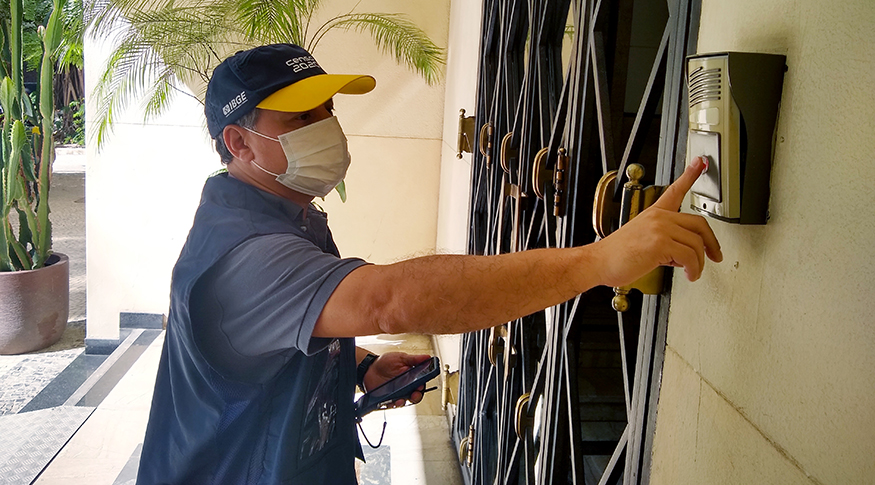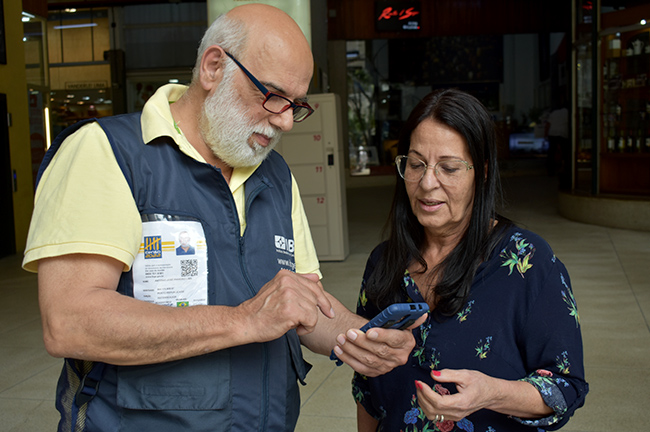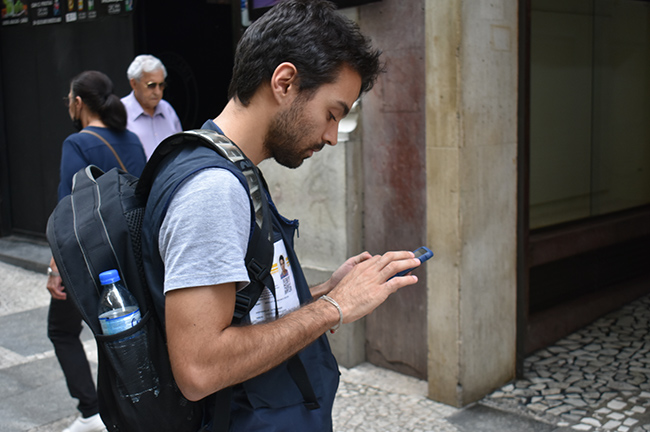2022 Census
IBGE works to reduce refusal rate and complete 2022 Census
February 02, 2023 10h00 AM | Last Updated: February 07, 2023 11h54 AM
Highlights
- Average refusal rate in Brazil is 2.43%. In São Paulo, leader in the ranking among the states, the percentage of those refusing to answer is 4.49%;
- Mato Grosso is the second state with the highest percentage of refusals in Brazil (3.38%), followed by Rio de Janeiro (3.21%).
- In the neighborhood of Consolação, the refusal rate is 33.85% (the highest rate in São Paulo); on the other hand, Brás has the lowest rate (2.45%).
- The average number of absent residents in Brazil is 4.62%. Among the Federation Units, Mato Grosso has the highest average number of absent residents (14.04%), followed by Espírito Santo (9.58%) and São Paulo (8.04%).
- Up to January 31, 185,827,709 people have been enumerated in 65,657,749 housing units in Brazil. It represents nearly 89.45% of the total population, according with the previous result of the Census (207.8 million people).
- Having virtually covered the enumeration areas, nearly 90% of the population have been enumerated.

After six months in the field, one of the major challenges to complete the 2022 Census is the high number of refusals to answer the questionnaire. In Brazil, the average rate hits 2.43%, considering data updated until January 31. That percentage is significantly higher in localities with higher concentration of population. In São Paulo, which leads the ranking among the states, the refusal rate is 4.49%, which is equivalent to 720 thousand households in which residents refused to provide information to the IBGE.
Luciano Duarte, the technical coordinator of the Census, reports that several forms of refusals have been noticed during the operation. He mentions that the training of the enumerators includes instructions to detect whether there are persons living in the house. “For instance, they will check whether theres is a dog at home, whether there are plants, whether there are clothes in the clothesline and then they will have an indication that that house is inhabited, regardless of having nobody at home in that moment,” says him
“In some situations during the approach, the enumerators perceive that there are persons at home, though they do not want to receive them. Otherwise the enumerators leave a message sheet in the mailing box or under the door, but they do not receive any feedback. These are situations of veiled refusal,” completes him. In other cases, residents even meet the enumerators, though they ask to return another time and, after successive returns in alternative schedules, they receive the same answer. That situation is also considered a veiled form of refusal by the Census technical team.

It happens frequently in the daily activities of enumerator Walquíria Nunes, who began to work in the Census in October last year. In the neighborhood of Santa Rosa, in Cuiabá, capital of Mato Grosso, she started her daily routine at 8 AM, though she used to extend her routine to meet residents at home.
“This was a medium-high-class neighborhood and I hardly found someone at home in the schedule I used for the visits. As I was at the college at night, sometimes I arrived late because I could only find residents around 5:30 or 6 PM. Many times they don´t want to meet us after that time as they fear an assault and it is quite dangerous to walk alone at night,” reports her.
Mato Grosso is the second state with the highest percentage of refusals in Brazil (3.38%) and Cuiabá also ranks in the second position among the capitals (4.3%). “We have been trying to return to the non-visited units at hours in which it is possible to find residents. There is a law that enforces residents to respond to the IBGE, which is always mentioned by the census agents,” says Millane Chaves, the IBGE Superintendent in Mato Grosso, who also highlights he delivery of letters and messages to residents and letters to condominium administrators and administrator associations.

With the high number of refusals and absent residents, Nunes tells that she took nearly two months to complete the enumeration areas of the first neighborhood she interviewed residents in the capital of Mato Grosso. “There were houses where I clapped and listened people inside, though the residents did not open the door. In other houses, people didn´t treat you bad, but looked at you and said that they would not receive us,” tells her.
Refusal is higher in higher class neighborhoods
The technical coordinator of the Census also highlights another form of refusal: whenever the rejection is not from residents, but from the condominiums themselves. “In order to approach an apartment, the enumerators have to be authorized by the porter or by the administrator. Hindrance of enumerators happens in fancier areas, like the South Zone in Rio de Janeiro or some high-class neighborhoods in São Paulo and in other states.
To detour that situation, the IBGE technicians developed a protocol that should be followed by enumerators and local coordinations. “There is a standard letter to be delivered to administrators and condominiums. Whenever that document doesn´t show any practical effect, enumerators are instructed to call the local police. That is the recommendation because, according to the law, nobody can hinder a housing unit to answer the Census. There are situations in which a single person tries to hinder an entire condominium to participate in the Census,” states him.
In Rio de Janeiro, the third state with the highest refusal rate (3.21%), the Census teams struggle to reverse the high level of rejection as well. “The main strategy is to prepare the servants at the time of the approach. It depends a lot on how the persons talk with the informants, how they explain the survey,” highlights José Francisco Teixeira Carvalho, the IBGE Superintendent in Rio de Janeiro.
He explains that, in situations of refusal, supervisors head to that places to check the situation. “If they don´t manage to do the interview, we send a first letter explaining the importance to answer the Census, including the telephone number of the enumerator to be contacted by the informant, as well as his id, allowing it to be checked in the 0800 number or on the IBGE portal,” says him.
He attributes the high number of refusals - nearly 194 thousand households in the state - to the population contingent and to the fear of violence. “Rio de Janeiro is the third state in population and the capital is the second most populated in Brazil, so the refusal rates are higher. It is also related to insecurity, because the informants are worried to open their doors and answer phone calls. The high refusal rate not only happens in the capital, but also in Baixada Fluminense and in cities of the metropolitan area, like Niterói and São Gonçalo,” states him.
“Earlier we had higher refusal rates in fancier areas, where residents have a higher purchasing power, like Barra da Tijuca, Lagoa and Ipanema, yet this is also spreading to other neighborhoods, like Méier, Madureira and Ramos, where we are also experiencing problems in terms of refusals,” concludes him.
That change was also noticed in São Paulo. Unlike the previous Census, refusals in São Paulo are not concentrated in the capital, but spread along several municipalities in the state. One of the highlights is Várzea Paulista, which has the highest refusal rate among the Brazilian municipalities (19.6%). In the capital, the district of Consolação also stands out in the percentage of residents who refuse to host the enumerators (33.7%).

“It is quite different than what happened in the last census campaigns. I attribute that to the new environment we are. We were in a pandemic, insecurity scales up and people are more sensitive, busy at their home offices and in other activities that did not exist in 2010. So, those things really took us to a data collection scenario very different than in the 2010 Census,” says Francisco Garrido, the IBGE Superintendent in São Paulo.
The superintendent reveals that one of the efforts to reverse the number of refusals in the most populated state in Brazil involves the movement of servants of the interior to the municipalities of the metropolitan area and to the capital. “They come to lead the work with IBGE vehicles. Those servants are ready to go to certain enumeration areas already mapped to fulfill their mission, either data collection or supervision and quality control,” explains Garrido. The extra personnel was required in a state that never filled 50% of the positions for enumerator.
Percentage of residents away from Brazil is 4.62%
In addition to the high level of refusals, the 2022 Census has also been registering high percentages of absent residents. The average percentage in Brazil was 4.62% up to January 31. For the purpose of comparison, the 2010 Census did not have a separate indicator for refusal and absent residents. The average percentage of both situations, together, reached 1.5% in the end of the census operation.
Among the Federation Units, Mato Grosso has the highest average number of absent residents (14.04%), followed by Espírito Santo (9.58%) and São Paulo (8.04%). The IBGE superintendent in Mato Grosso states that at least four visits are made to the same households whenever the residents are not found at home in these occasions, and at least one of them is made out of business hours. “We have cases of returning ten times to households without success,” says her.
Garrido attributes the high percentage of that indicator in São Paulo to cultural changes.
“The work dynamics affected it a lot. The average number of residents decreased in the state of São Paulo and people work and study. So they usually have a daily routine of going to their work and staying for studying. That also jeopardized the collection of information, since that, in some cases, the enumerators returned more than the usual four times established in the manual. We had to return up to ten times to certain households or condominiums to fulfill the data collection and even so we ended with high percentages of absent residents,” points him out.
Refusal rate in São Paulo is the highest one in Brazil and requires strategies from enumerators
The refusal rate reflects the population size of São Paulo. 46.6 million people live in a territorial area of 248,219.485 km2, a population larger than countries like Belgium and Netherlands, for instance. Only in this state, nearly 4.49% of the residents refused to answer the survey, resulting in the highest rate in Brazil (information updated on January 31, 2023). For the purpose of comparison, the average refusal in Brazil is 2.43%. A number of factors can explain these data, like the difference of income among the localities, for example.
According to the 2010 Census data, the average income of the residents who live in the districts of Consolação and Santa Cecília is three times higher than those of Brás or Pari. All the districts mentioned are located in the central region of São Paulo, i.e., a single region have spaces with different socioeconomic aspects.
That is reflected in the 2022 Census: in Consolação, the refusal rate is 33.85% (the highest rate of São Paulo); on the other hand, Brás has the lowest rate (2.45%). These data show that districts where the residents have higher earnings usually have higher refusal rates, whereas the districts in which residents have lower earnings have lower rates.
For Antônio Lima, an enumerator of the central region of the municipality of São Paulo, refusals completely impact the work of enumerators. “As an enumerator, I want to fulfill as many questionnaires as possible, not only due to the financial issue, because we earn according to our productivity, but also to deliver the information that the IBGE needs. To make it happen, you have to insist by calling several times to residents,” explains him.

“I managed to call a person six times. - I will answer you soon. But they don´t answer. There are people who don´t take our work seriously. In contrast, there are very friendly and kind residents who treat us very well, helping our work,” vents Lima.
An strategy he uses to reduce refusals is to be friendly and kind in the first approach. “If it doesn´t work, I keep on insisting, always with respect.” At Copan, an iconic building designed by Oscar Niemeyer, Lima reminded when he tried to enumerate a resident. “I looked for him for a month, without success. As I also live at Copan, I always greeted him, but he could never talk with me. In the last day I enumerated the building, I met him at the elevator and said - Now you will respond! He answered - You win! Then I managed to do it,” tells Lima.
Wesley Mendonça, 24, is working as an enumerator since the beginning of the data collection. Based on his experience, he states that refusals not only affect his performance, but also his self-esteem. “Whenever rejected by a resident, I use to think - Am I approaching the residents in the wrong way? Are people questioning me? When that happens, enumerators feel an imposter syndrome and gets disappointed, as they think they are not managing to convince the population to take part in the Census. Besides, whenever an administrator or a porter remains indifferent to the enumerators, it is usual to think that our work doesn´t have any importance,” comments him.

In order to increase the responsiveness of the public in relation to the census data collection, Mendonça has been adopting certain approaching techniques. “Many times people don´t understand the importance of the Census; so, I explain the social role of the survey. In addition, I also manage to follow when residents arrive and leave, because it is a key issue to be well received.”
Enumeration in condominiums in São Paulo is streamlined by Condominium Association
The landscape in São Paulo is surrounded by a sea of buildings These households are usually more difficult to be accessed by enumerators. To detour this problem, condominium associations work in this Census to mitigate the insecurity issue when receiving enumerators.
For José Roberto Graiche Júnior, President of the Association of Administrators of Real Estate and Condominiums of São Paulo (AABIC), it is mandatory that residents in buildings understand the importance of the survey in order to receive the enumerators and provide the information requested correctly.
Concerning security, Graiche states that working in partnership with administrators and condominium members is key to reduce the refusal rate. “What usually happens is that enumerators are still hindered in the buildings, delaying the survey. In face of this scenario, the AABIC established an unprecedented partnership with the IBGE in São Paulo to guarantee the accomplishment of the 2022 Census, by means of dissemination material and letters involving all the condominiums, administrators and employees. In addition, we always warn administrators to previously check the id of the enumerators on the IBGE portal, aiming at guaranteeing the security of everybody.”
Disk Census 137
An unprecedented service in the census operation in Brazil, Disk Census was made available by the end of last year. Through it, people not yet enumerated have the opportunity to call and request the visit of enumerators.
“Initially, Disk Census was available in 18 municipalities of the state; later, we requested it to cover all the municipalities, which is already done. Lately we receive nearly 250 to 300 daily calls. We pass it on to those responsible for that area and they allocate an enumerator for the household that requested it,” explains the IBGE Superintendent in Rio de Janeiro.
Beyond 137, informants who did not answer the Census questionnaire should call 0800 721 8181, which will be available until February 20 or look for an IBGE branch in their cities.
Having virtually covered the enumeration areas, nearly 90% of the population is enumerated
Since the start of the operation, on August 1st, up to January 31, 185,827,709 persons had been enumerated, in 65,657,749 housing units in Brazil. According to the previous result (207.8 million people), that represents nearly 89.45% of the Brazilian population. In relation to the estimated figure, 213.3 million, the contingent of enumerated people corresponds to 87.11%.
The coverage of the enumeration areas was virtually completed in January 2023. Census revision, quality control and calculation will be underway in February and March, including attempts to reverse refusals, new visits to households with absent residents to carry out interviews, as well as identification of vacant housing units, of occasional use, possible duplicities and omissions and preparation for dissemination. It is scheduled that the IBGE will release the final Census results related to the population of municipalities in April 2023.





















